
Chapter 11: Just For Fun
All work and no fun is . . . well . . . no fun. Catch the fun fever and become a top domino toppler. Get the lowdown on how videos are made, how fireworks light the skies, and how balloons become animals.
HOW does an idea become a book?

Ideas for books come from many people. Experienced writers, editors (who select texts to publish, and make changes and corrections), agents (who connect writers and editors), and those outside the publishing business can all generate ideas. Even if someone has never published a book before, he or she can pitch an idea to an agent or editor, who may agree to help develop it.
A book idea can start with a phrase, a title, a person you know or are interested in, a historical event, or an experience you’ve had. Do you have a book idea? Is your idea for a nonfiction book, which could be based on a true story, a real person or thing, or a historical event? Or is it fiction—a made-up story?
1. WHAT’S THE STORY?

Once you’ve figured out what you want to write about, it’s time to think about what your book will look like. Will it be a chapter book, a picture book, or perhaps an information book about animals that live in the ocean? Where will the story be set? Will the action happen in a single day or over time? These are the sorts of things a writer needs to figure out when turning an idea into a manuscript.
2. WRITING IT

The next step is to create a manuscript—the text of the book. Usually the writer will start by creating an outline. Then the writer will compose the sentences, reviewing over and over and making rewrites. If a writer is able to interest an editor in a manuscript, then the writer and editor work as a team to ensure the book contains the right information for the intended audience.
3. EDITING

The writer shares the work in progress with the editor, who provides feedback. The editor may change some language to make it clearer, verify facts, and offer suggestions about how to tell the story. Revision and rewriting are key: the manuscript goes back and forth between writer and editor several times.
4. DESIGNING AND MANUFACTURING

As the HMS Scout dove deep, Cam saw something amazing.
It was gray.
It was BIG.
It was a humpback whale!
Once the manuscript is ready, a copyeditor corrects punctuation and grammar mistakes. Then off the text goes to a designer, who turns an ordinary typed document into pages with art, using special computer programs for graphic design. A proofreader checks the designed pages for errors. Then an electronic file is dispatched to a printer. And—presto! A physical book is born.
Fast Fact
Making a book is a collaborative effort—it requires the skills of many people. In addition to a writer, an editor, and a designer, a book needs a project manager to assign deadlines and keep team members on track.
HOW is a fireworks show staged?

The Fourth of July isn’t the same without a fireworks display. The experts who put on these shows are called pyrotechnicians (pi-roh-tek-nish-unz). They build and shoot off the fireworks. To create a spectacular show, pyrotechnicians must figure out what types of fireworks should go off—and in what order. They must think about the colors, sounds, heights, and patterns of the fireworks. In some shows, the fireworks must match up with music. Pyrotechnicians are the only people legally allowed to handle fireworks in most states. Leave fireworks to the experts, and enjoy the show! Here is how a professional fireworks show is put on.
1. The first step in staging a professional fireworks show involves setting up hundreds of steel tubes called mortars. A mortar holds a single firework, called a shell. Mortars are placed at different angles so the fireworks will explode in different areas in the sky.

2. A pyrotechnician places a shell in each mortar. At the bottom of the shell is gunpowder. When the powder explodes, it sends the shell into the sky.

3. Before the show, workers begin to connect the fireworks to a firing panel with wires. The firing panel sits far from the mortars.

4. The fireworks are set off far enough away from spectators so pieces of the exploding shells won’t land on the crowds. At a July Fourth fireworks display in New York City, they were set off from a barge in the middle of a river.
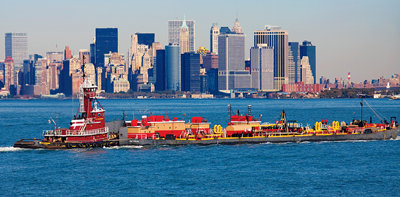
5. At the press of a button, an electric current ignites the powder in a mortar. One by one, the fireworks blast 300 to 600 feet into the sky and burst into colors. The final fireworks, the finale, is loud and spectacular. The crowds applaud.

IT’S A BLAST! An aerial firework is a firework that explodes high in the air. To build one, an expert places a fuse in a shell, or paper tube. The shell is packed with black powder, as well as chemicals formed into little balls or cubes, called stars. It’s the stars that give the fireworks their colors and patterns in the sky. Finally, the shell is wrapped in thick paper hardened by paste and shaped into a cylinder or sphere.
When a firework is lit, black powder in the bottom of the shell rockets it out of a mortar and into the sky. As the firework rises, the fuse inside the shell burns down. When the shell reaches its peak, the fuse lights the black powder in the shell. The exploding powder makes the stars burn in a shower of colorful sparks.

HOW do you lay out and topple dominoes?

Tenth Annual Domino Toppling Extravaganza (Brattleboro Museum & Art Center, 2017)
Dominoes topple like . . . well . . . dominoes. Knock over the one at the head of the line, and it sets in motion a chain reaction—sometimes a very loooong chain reaction. In 2009, one display in the Netherlands toppled 4.5 million dominoes!
So how can you create one of these elaborate constructions? The pro advice is to start simple. Set up a short, straight line of dominoes—each about half an inch apart—to get the hang of the process. Bring lots of patience: it can be frustrating if one domino falls before they’re all in place and you have to start again from scratch.
Did You Know?

In April 2017, the California state domino toppling record was broken at the San Jose Children’s Discovery Museum when high school students set up and toppled 25,000 dominoes.

SPLITS A split is where the last domino in a line topples two side-by-side tiles, which in turn knock down two separate lines.

CURVES Form a curved line by placing tiles at a slight angle—a 30-degree angle is good—to the left or right.
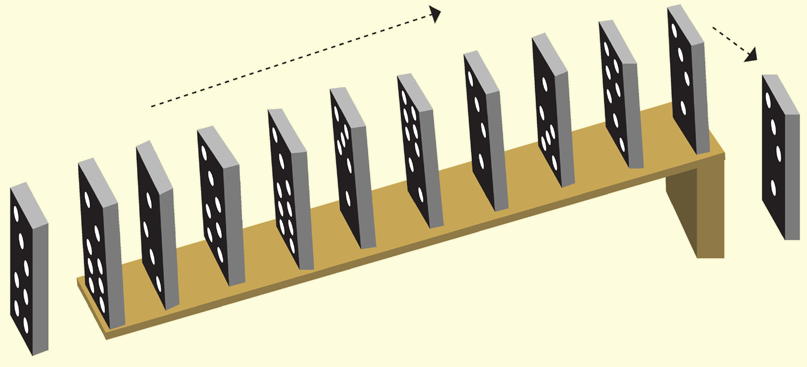
RAMPS Another trick to incorporate is a ramp—but be careful it isn’t too steep, or the tiles won’t fall neatly.

DIAMONDS With an initial split, it’s possible to form a diamond pattern.
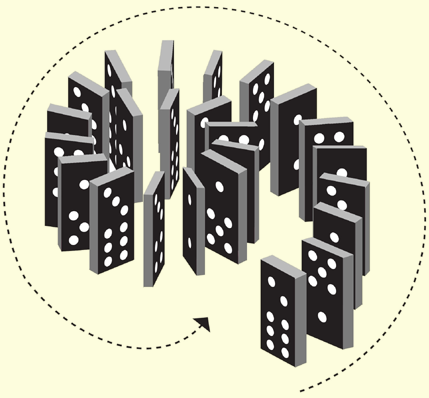
SPIRALS Anything but basic, domino spirals use the same technique you use to make curves.
PRO TIP When setting up a large display, leave a number of wide gaps between the tiles at intervals. That way, if you accidentally knock over a tile, the entire display won’t come crashing down. Once the display is complete, fill in the gaps before setting the dominoes in motion.
HOW does a new word get into the dictionary?
Dictionaries are books of words. The words are generally listed in alphabetical order, from A to Z. Each word’s entry includes a definition, which explains what the word means and how it’s used. While English-language dictionaries have been around for more than 400 years, they haven’t always included the same words. Here’s a look at how new words are added to a dictionary.

YOLO
interjection
1. “You only live once”; used to express the view that one should make the most of the present moment without worrying about the future (often as a rationale for impulsive or reckless behavior)
As Hannah parachuted out of the plane, she yelled, “YOLO!”
FIRST Dictionary editors read a lot to find new words. They read books, magazines, newspapers, and online materials. They use computers to track how often new words are used and over what period of time. Editors also look for new uses or spellings of existing words. They mark words that are used often and in interesting ways.
NEXT Marked words may be tracked on index cards, by computer, or both. Each word’s record includes examples of usage and information about where it has been used. This record is called a citation. Citation databases may contain millions of words that are being tracked.
THEN Editors review citations regularly. They determine whether a marked word has been used enough, if it adds enough new meaning to the language, and whether it should be considered for entry into the dictionary. They also decide whether a word has faded from use and should be dropped from the citation database.

FINALLY The Oxford English Dictionary (OED), first published in 1884, contains more than 600,000 words today. Every three months, editors update the dictionary. In September 2016, they added more than 500 new words. Here are a few of those new words, along with their definitions and an example sentence for each (on the following pages).

card reader
noun
1. an electronic device that reads a magnetic strip or bar code on a credit, debit, or identity card
Before her groceries were bagged, Priya swiped her card through the card reader.

cheer squad
noun
1. a team of cheerleaders
The cheer squad posed for a team picture.
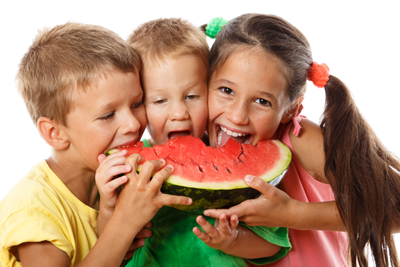
scrumdiddlyumptious
adjective
1. extremely scrumptious; excellent, splendid; (esp. of food) delicious
The juicy watermelon is scrumdiddlyumptious.
Here’s why you should own a print or digital dictionary:
• To look up unfamiliar words you come across in books, in articles, and online.
• To help with spelling when you’re doing homework or playing word games with friends.
• To build your vocabulary by increasing the number of words you know and use.
• To figure out which spelling to use when two words sound alike, such as principal (the head of a school) and principle (a rule or belief).
PARTS OF SPEECH
Noun A person, place, or thing: teacher, carrot, friendship. It may be preceded by an article (the, a, an).
Pronoun Takes the place of a noun: you, they, it.
Verb Expresses an action or a state of being: to jump, to love.
Adjective Describes a noun: good, hot, blue.
Adverb Modifies (adds to or changes) the meaning of a verb, telling something like where, when, how, or how much: outside, later, slowly, very.
Preposition Shows how something is related to the rest of a sentence: by, about, with.
Conjunction Joins words, phrases, or parts of sentences: and, but, or.
Interjection Expresses emotion: Wow! Ugh! Ouch!
HOW do roller coasters go up and down?

A roller coaster is like a scary movie: it gives riders thrills and chills without putting them in danger. How do these scream machines move people up, down, and around? It takes energy. As a roller coaster car is pulled up the first hill, it stores potential energy. The higher it goes, the more potential energy it has. When gravity pulls the coaster down the track, the coaster releases the potential energy. Now it has kinetic energy, which is the energy an object has when it moves. The faster an object moves, the more kinetic energy it has. The coaster is moving fastest after it goes down the first and highest hill. This gives the car enough energy to go up the next hill.
A coaster can’t go up and down hills forever. Air resistance and the friction of the wheels against the track make the car lose energy and eventually slow down. That’s why each hill is smaller and smaller.
1. Safety bars and heavy seat belts keep riders inside the car.

2. Motorized chains pull the cars up the first hill. Some rides use magnets in the cars and track to pull the cars quickly up the first hill.

3. The first hill is the highest. The coaster gains enough kinetic energy going down this first hill to go up the next hill.
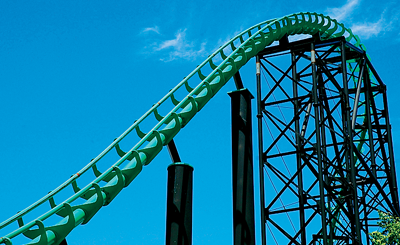
4. The second hill is next highest. At the bottom of the second hill, the coaster has just enough energy to reach the top of the third hill.

5. Three sets of car wheels run above, under, and alongside the track. They keep the cars locked when they make twists, turns, and loop-de-loops.

Riders on a loop-de-loop don’t fall out thanks to centrifugal (cen-trif-uh-gull) force. The force of the cars moving in a circle pushes riders back toward the floor of the cars. It’s the same as when you whirl a bucket of water in a big circle around your head. The water stays in the bucket!

If you're looking for the world's fastest roller coaster, you'll have to travel to Abu Dhabi, in the United Arab Emirates. The Formula Rossa coaster at the Ferrari World amusement park can reach a top speed of 149 miles per hour! It doesn't waste any time, either, hitting 60 miles per hour within a mere two seconds of launching.


 Highest Roller Coasters in the World
Highest Roller Coasters in the World
Coaster: 1. Kingda Ka
Height (feet): 456
Amusement Park: Six Flags Great Adventure
Location: Jackson, New Jersey
Coaster: 2. Top Thrill Dragster
Height (feet): 420
Amusement Park: Cedar Point
Location: Sandusky, Ohio
Coaster: 3. Superman: Escape from Krypton
Height (feet): 415
Amusement Park: Six Flags Magic Mountain
Location: Valencia, California
Coaster: 4. Tower of Terror II
Height (feet): 377
Amusement Park: Dreamworld
Location: Coomera, Australia
Coaster: 5. Red Force
Height (feet): 367.4
Amusement Park: PortAventura Park
Location: Salou, Spain
HOW is a short online video produced?

Online video production involves many people with different skills working as a team. And like making a movie or television show, video production is broken down into specific steps. Producing even a short online video can be a lengthy task, and having a set work pattern makes the process flow smoothly. It also helps avoid the costly process of having to do it a second time. Preproduction, production, and postproduction are the three steps in making a video.
POPULAR ONLINE VIDEO CATEGORIES
Online videos run the gambit from video blogs (vlogs) to cooking shows, to silly skits. But some categories are more popular than others. These are the four most popular types:

NEWS

HOW TO

COMEDY

MUSIC
 Most Popular Youtube Videos of 2016
Most Popular Youtube Videos of 2016
Video: 1. Carpool Karaoke with Adele
Views (millions): 135.8
Video: 2. Pen-Pineapple-Apple-Pen/PIKO-TARO
Views (millions): 95
Video: 3. What’s Inside a Rattlesnake Rattle?
Views (millions): 59.5
Video: 4. Nike Football Presents: The Switch Featuring Cristiano Ronaldo
Views (millions): 57
Video: 5. Grace VanderWaal: 12-Year-Old Ukulele Player Gets Golden Buzzer
Views (millions): 46.4
VIDEO 101 Whether you’re making a blockbuster action movie or a lip-sync video to post online, there are basic steps to follow before, during, and after filming.

PREPRODUCTION Preproduction is everything that needs to happen before the cameras start rolling: coming up with a concept for the video, writing a script, and assembling the equipment. Many small and often unpredictable details are involved—for instance, scouting for places to set the action and acquiring the necessary filming permits.

POSTPRODUCTION Once shooting is complete, it’s time for postproduction. The video editor selects clips, or shots, from the footage and edits them together so they tell the desired story. The editor also ensures that the dialogue (talking) and images are in sync. Often sound effects, music, voiceover narration, and graphics are added. Once it's completed, it's time to encode the video so it can be played on sites like YouTube.
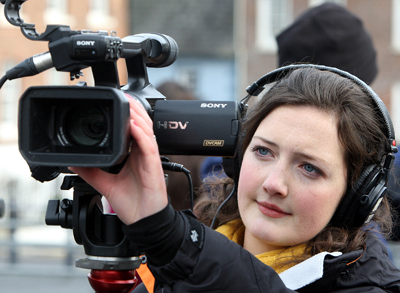
PRODUCTION Production is the actual shooting, or filming, of the video. Most video content today is shot on digital cameras, or even digital devices such as smartphones or laptop webcams. The type of camera used depends on the size and budget of the shoot. A webcam may be sufficient for someone creating a simple instructional YouTube video. More involved shoots, however, may require digital camcorders with built-in audio, special zoom lenses, and other advanced features.
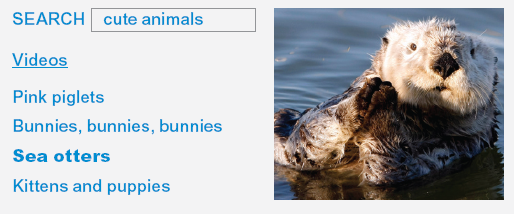
GETTING THE WORD OUT Sometimes an online video goes viral, which means it’s shared rapidly through social media. Search engine optimization (SEO) is important. It helps search engines such as Google find something specific. For example, if the video is about sea otters being utterly adorable, using SEO tools can help ensure that the video turns up when someone searches “cute animals.”
Did You Know?

Using a series of drawings called storyboards, based on a script, filmmakers map out each shot they will take before they film. The process helps them figure out how to set up shots, where to make edits, and how to order the action. Good storyboarding saves time during production and postproduction.
HOW TO make a balloon animal
Becoming a master balloon twister takes lots of practice, but almost anyone with a little patience and dexterity can quickly grasp the basics. Step one is to inflate a balloon, but only partially. Then tie it off. Twisters leave balloons partly inflated so they can shape them without popping them.
Once the balloon is tied off, the twister uses a combination of techniques to create an animal. The basic twist involves rotating the balloon to create two separate segments. The lock twist puts two basic twists around each other so they “lock” into place. For a loop or fold twist, a long, thin balloon is folded in half and the two ends are twisted together to form a loop.
Professional twisters use what are called 260 balloons, which are designed for twisting. Their pencil-like shape makes them easy to manipulate. The 260 means that, when inflated, each balloon is two inches in diameter and 60 inches long.

What you need:

• A long, thin 260 balloon
• A handheld air pump (optional, but easier for blowing up the balloon)
What to do:
1. Inflate the balloon, leaving three inches unfilled for the tail. Knot the balloon securely.

2. Use basic twists to create four segments: the first segment for the dog’s nose, the second and third for its ears, and the fourth for its body.

3. Twist the second and third segments together in a lock twist to form a nose and ears.

4. Twist a few inches below the head to make the dog’s neck. Make two more segments below the neck for the legs. Twist the legs together in a lock twist.

5. Twist the remainder of the body three times to make four segments. The first will be the body, the second and third the back legs, and the last the tail.

6. Fold the balloon at the twist between the two leg segments. Hold them together and twist them around the end of the body segment. The tail will then fill up. Doggie done!

WARNING Balloons can pose a choking hazard to babies and toddlers. Always keep balloons away from very young children.
More fun!
Balloon artists often specialize in either single-balloon models (designs made with just one balloon) or multiple-balloon models (which are made of many connecting balloons). With multiple balloons, they can create almost anything.

Caterpillar

Butterfly

Horse
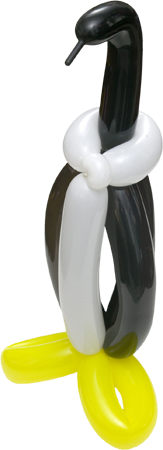
Penguin